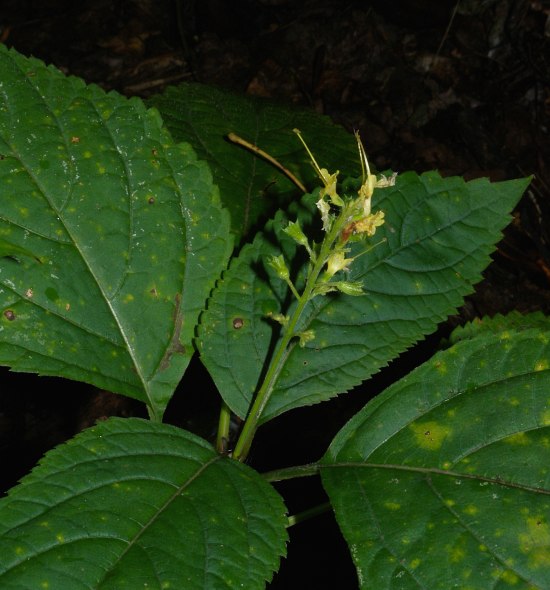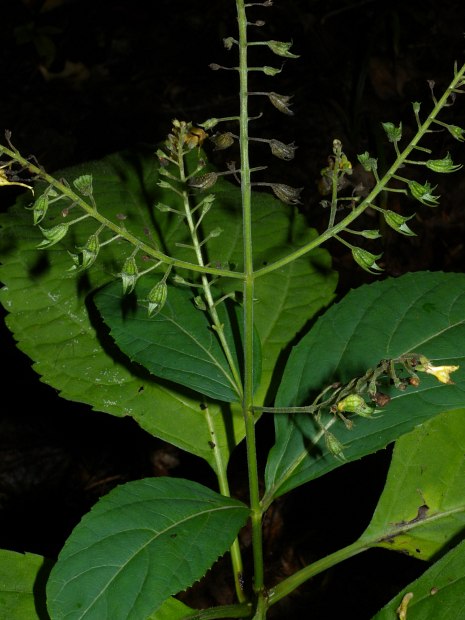
Individual flowers are about 1/3–1/2" (8–13 mm.) long, consisting of a short-tubular to bell-shaped green calyx with 5 teeth, a two-lipped tubular corolla that is predominately cream-colored or yellow, 2 long-exserted fertile stamens, and an ovary with a slender style that is also long-exserted. The calyx is minutely pubescent and glandular-punctate; it has 2 linear-lanceolate lower teeth and 3 linear-deltate upper teeth; the lower teeth are longer than the upper teeth. The calyx also has 10 narrow longitudinal ridges that are dark green. The corolla has a narrow tubular base, but it becomes wider and more trumpet-shaped towards its mouth with 5 spreading lobes (2 upper lobes, 2 lateral lobes, and 1 lower lobe that is larger in size). The upper and lateral lobes are either oval or oval-deltate in shape, while the lower lobe is violin-shaped, mostly white, and heavily fringed along its outer lip. Sometimes there are reddish stripes or bars along the upper and middle lobes of the corolla, while either patches or stripes of faded red may occur toward the base of the lower lobe. The throat of the corolla is a little wider than tall, where there is a patch of fine white hairs. The filaments of the stamens are white, light yellow, or light greenish yellow, while the fertile anthers are either white or light yellow. The slender style is dark red and usually bent toward one of the stamens. The pedicels of the flowers are about 1/8" (3 mm.) in length or slightly longer; they are light green and short-pubescent.

The blooming period occurs from mid-summer to early autumn, lasting about 3-4 weeks. Both the flowers and foliage have a lemon or citronella scent. Afterwards, the flowers are replaced by small nutlets (0-2 nutlets per flower); they develop within enlarged calyces. Individual nutlets are about 1.5 mm. across, globoid but somewhat flattened in shape, and dark brown. The root system consists of hard woody rhizomes with coarse fibrous roots. This plant often forms clonal colonies from its rhizomes.
Cultivation: The preference is medium to light shade, mesic conditions, and mildly acidic soil containing humus and loam. This plant is an excellent choice for a shade garden under deciduous trees.
Range & Habitat: Richweed (Collinsonia canadensis) is uncommon in east-central Illinois and southern Illinois, where this plant is native, while in the rest of the state it is absent (see Distribution Map). Illinois lies along its western-range limit; Richweed is more common further to the east. Habitats include rich woodlands, rocky upland woodlands, wooded areas in rocky river valleys, and less often elevated areas in swamps. This plant tends to occur in oak-hickory woodlands and beech-maple woodlands, especially in areas where sandstone bedrock is not far from the ground surface.

Faunal Associations: Bumblebees are the primary pollinators of the flowers, where both nectar and pollen are available as floral rewards (Skinner, 1976). Several species of insects are known to feed on Richweed (Collinsonia canadensis); many of these species are monophagous or oligophagous. These insect feeders include larvae of the gall flies, Dasineura collinsoniae and Lasioptera collinsonifolia, such aphids as Hyalomyzus collinsoniae and Hyalomyzus eriobotryae, Amblycorypha rotundifolia (Round-winged Katydid), and the larvae of such Noctuid moths as Psectrotarsia herbardi (Horse-balm Sun Moth), Papaipema astuta (Yellow Stoneroot Borer Moth), Papaipema duplicatus (Dark Stoneroot Borer Moth), and Papaipema nebris (Stalk Borer Moth); see Felt (1917), Blackman & Eastop (2013), Gangwere (1961), and Natural History Museum (2010). Slugs also feed on the flowers of Richweed (personal observation, 2017). Among vertebrate animals, the seeds of this plant are eaten by the Bobwhite Quail and possibly other birds (Miller & Miller, 1999). White-tailed Deer and other mammalian herbivores usually avoid this plant as a food source.
Photographic Location: A rocky woodland at the Pine Hills State Nature Preserve in west-central Indiana.

Comments: This wildflower produces flowers in late summer when there is little else in bloom in shady woodlands. While bumblebees have been reported to be the primary pollinators of the flowers (Skinner, 1976), the long-exserted stamens and styles of the flowers, the white fringe of the lower lip of the corolla, and the fragrance of the flowers suggest that moths also visit the flowers for nectar. When the flowers of Richweed (Collinsonia canadensis) are in bloom, this plant is fairly easy to identify because of their distinctive appearance. Otherwise, it may be difficult to distinguish this species from other plant species that grow in woodlands, such as Scrophularia (Figwort) and Agastache (Giant Hyssop). A non-native species that is becoming invasive in wooded areas, the green-leaved form of Perilla frutescens (Beefsteak Plant), could also be confused with Richweed on the basis of its foliage. However, the flowers of the Beefsteak Plant do not have a deeply fringed lower lip nor do they have strongly exserted stamens and styles. The lemon-citronella fragrance of the foliage of Richweed, however, can be used to distinguish it from these other plants. While there are several similar-appearing Collinsonia spp. in southeastern USA, none of them occur in Illinois. Other common names of Collinsonia canadensis include Stone Root and Northern Horse Balm.